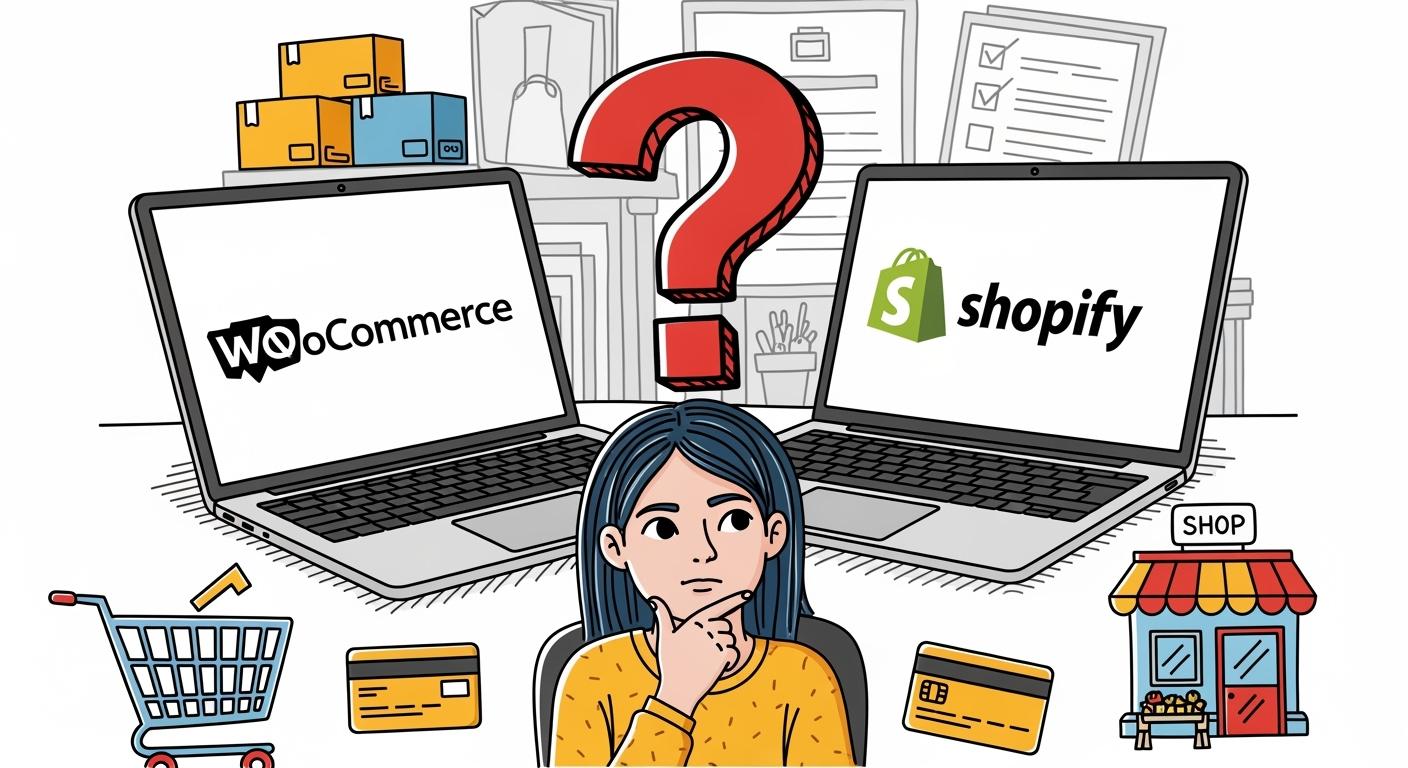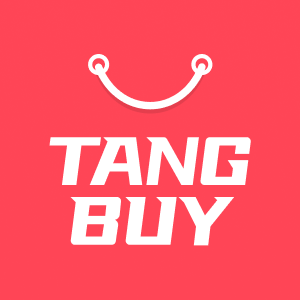WooCommerce vs Shopify: Which Platform Is Better for Beginners in 2025?

Comparing WooCommerce and Shopify for Beginners
Explore the key differences between WooCommerce and Shopify for new users in 2025.
Features | WooCommerce | Shopify |
|---|---|---|
Setup time | 2–4 weeks for full setup | 1–2 weeks for most stores |
User-friendliness | Moderate learning curve | Very easy for beginners |
Support | Community + agency/host support | 24/7 Shopify support included |
Pricing | Free plugin, hosting costs apply | Subscription-based, includes hosting |
Technical needs | WordPress knowledge helps | No technical skills needed |
Customization | Highly customizable with plugins | Limited customization options |
Payment options | Flexible, no extra fees | Built-in options, extra fees for others |
Shipping setup | Requires plugins for advanced features | Built-in tools for easy setup |
Security | Depends on hosting for SSL | Built-in SSL protection |
Updates | Manual updates required | Automatic updates handled |
If you want to start selling online quickly in 2025, Shopify is often easier for beginners. It has a simple setup, and you receive helpful support. Managing your shop is smooth. In contrast, WooCommerce vs Shopify shows that WooCommerce allows you to change more aspects and have greater control. However, you may need to undertake extra steps, such as selecting plugins or adjusting design settings. Many new users find the settings for products, shipping, or taxes on WooCommerce confusing. On Shopify, most features function immediately. You will see all the main differences explained clearly here.
Key Takeaways
Shopify is great for beginners because it is easy to set up. It has a simple interface that is easy to use. WooCommerce lets you change more things, but it is harder to use. You need more technical skills and more time to set up WooCommerce. Shopify gives you help any time of day or night. WooCommerce uses community forums if you need help. WooCommerce does not cost anything to install. But you will pay extra for hosting and plugins. Shopify has a clear monthly fee that covers hosting. Shopify has built-in tools that make product management easy. These tools also help with shipping and save you time. WooCommerce lets you control your shop’s look and features. This is good if you like to customise things. Both platforms have strong communities and lots of resources. But Shopify gives you faster help if you have urgent problems. Think about what matters most to you. Pick Shopify if you want things to be easy and quick. Pick WooCommerce if you want more control and flexibility.
Quick Comparison

WooCommerce vs Shopify Overview
WooCommerce and Shopify are two different ways to make an online shop. WooCommerce is a plugin for WordPress. You can change many things in your shop with it. Shopify gives you a platform that is ready to use. You just sign up, choose a template, and start selling. You do not have to think about hosting or security.
Here’s a quick side-by-side look at the main differences:
Criteria | WooCommerce | Shopify |
|---|---|---|
2–4 weeks (custom builds longer) | ||
User-friendliness | Moderate learning curve | Very easy for beginners |
Support | Community + agency/host support | 24/7 Shopify support included |
Pricing | Free plugin, hosting and security costs apply | Subscription-based, includes hosting and security |
Technical needs | WordPress knowledge helps | No technical skills needed |
WooCommerce vs Shopify is not only about features. It is also about how much time and effort you want to spend.
Key Criteria
Let’s look at what is most important for beginners:
Setup: Shopify helps you open your shop fast. You pick a design, add products, and your shop is live. WooCommerce takes more time. You must set up WordPress, find hosting, and add plugins.
Ease of Use: Shopify is great for beginners. A survey showed 95% of users said Shopify was easy to use. Its dashboard is simple and clear. WooCommerce can be hard if you have not used WordPress before.
Support: Shopify gives help all day and night by phone, email, or chat. WooCommerce has a big community and many guides. You might need to search for answers or ask in forums.
Cost: WooCommerce is free to install, but you pay for hosting, security, and extras. Shopify has a monthly fee that covers hosting and security. You know what you will pay each month.
Features: WooCommerce lets you change your shop in more ways. Shopify has more built-in tools and unlimited customer service.
Tip: If you want to start selling fast and easy, Shopify is usually best for beginners. If you want more control and do not mind learning, WooCommerce gives you more choices.
Ease of Use
Setup Steps
WooCommerce
Setting up WooCommerce takes more work. First, you buy a domain name. Then, you set up your hosting account. Next, you install WordPress. After that, you add the WooCommerce plugin. You must set up basic store details and pages. Then, you add products with titles and descriptions. You change how your shop looks with a theme. You might need to pick plugins for payments and shipping. These plugins add extra features. Tracking sales helps you see your business grow.
Shopify
Shopify makes starting your shop much easier. You choose a shop name and add your phone number. You also enter your email address. You pick your shop currency. Connecting a domain is simple. You can use one you have or buy a new one. Shopify gives you many themes to choose from. Some are free and some cost money. You pick a theme and change it with a drag-and-drop builder. Adding products is easy in the dashboard. You click the 'Products' tab to start. Setting up payments is quick in the admin area. When your shop is ready, you launch it.
Tip: Shopify’s guided setup helps you get online fast. It saves you time and stress.
Store Management
Products & Orders
Managing products and orders is something you do every day. WooCommerce and Shopify work differently here.
WooCommerce | Shopify | |
|---|---|---|
Product Management | Lets you handle many product types, including simple and variable products. | Makes adding products quick and easy, with simple organisation into collections. |
Inventory Tracking | Tracks stock levels and sends low stock alerts. | Updates inventory in real time, even across multiple sales channels. |
Customer Management | Offers basic tools for managing customers. | Gives you advanced customer management, including email marketing and analytics. |
Analytics & Reporting | Needs extra plugins for detailed analytics. | Includes built-in analytics and reporting for sales and customer behaviour. |
Payments & Shipping
WooCommerce lets you pick from many payment gateways. You also choose shipping plugins. You must install and set up these yourself. Shopify has payment and shipping tools built in. You just turn them on in the dashboard. You do not need to look for extra plugins.
Note: Shopify’s built-in features save you time. You spend less time on technical jobs and more time selling.
Learning Curve
WooCommerce and Shopify are different when it comes to learning.
WooCommerce gives you lots of choices. You need to learn how WordPress works. You must install plugins and set up settings yourself. This can be hard if you have never made a website before.
Shopify is made for beginners. You get a simple interface and guided setup. You do not need coding or technical skills. The drag-and-drop builder makes changing your shop easy.
Managing products and orders in Shopify is simple. You do not have to learn a lot. WooCommerce takes more time to understand themes and plugins.
If you want something easy from the start, Shopify is best for most beginners.
Callout: You do not need to be a tech expert to run a Shopify shop. WooCommerce gives you more control, but you must be ready to learn new things.
WooCommerce and Shopify are a choice between control and ease. If you want to spend less time learning, Shopify helps you start fast. If you like changing every detail and do not mind learning, WooCommerce gives you more options.
Pricing & Costs
When you compare WooCommerce and Shopify, price matters a lot for beginners. You want to know what you pay at first and what costs might come later. Let’s look at the fees so you can plan your money well.
Startup Fees
WooCommerce
WooCommerce is free to start, but you must pay for some things before your shop opens. You buy a domain name, which costs about £10 to £15 each year. You also need hosting for WordPress. Basic hosting costs about £5 to £10 each month. If you want a special theme or plugin, you pay more. Most beginners spend between £50 and £200 to set up their WooCommerce shop.
Shopify
Shopify makes starting costs easy to understand. You pick a plan and pay every month. Here are the main choices for 2025:
Basic Shopify: £25 each month
Shopify: £65 each month
Advanced Shopify: £344 each month
You can use a free theme or buy a premium one. Shopify gives you hosting and security in the monthly price. You do not pay for those by themselves. You might pay more if you want extra apps or a custom domain.
Tip: Shopify’s simple prices help you avoid surprises when you open your shop.
Monthly & Transaction Fees
Ongoing Costs
Running your shop means you pay monthly fees and transaction charges. Here is how both platforms compare:
Platform | Transaction Fees (Example) | |
|---|---|---|
Shopify | $29 - $299 | 2.9% + 30¢ (Shopify Payments) |
WooCommerce | £10 - £20 (basic costs) | No platform fees; only payment processor fees |
With WooCommerce, you pay for hosting and plugins you use. These costs can grow if you want more features. Shopify’s monthly fee covers hosting, security, and support. You pay extra for apps and special features.
You also need to think about transaction fees. WooCommerce does not charge platform fees, so you only pay the payment processor, like Stripe or PayPal. Shopify charges transaction fees if you use another payment gateway. These fees range from 0.5% to 2%. They can lower your profits if you sell a lot.
Note: WooCommerce can help you save money on transaction fees, which helps your profits grow over time.
Hidden Charges
Some costs are not clear at first. You might pay for extra features, upgrades, or services as your shop gets bigger. Here are some common hidden charges for both platforms:
Hidden Cost | Description |
|---|---|
Extension renewal fees | Yearly renewals for premium extensions, usually 50-100% of the first price. |
Developer costs for customisations | Paying a developer for custom work can be costly. |
Security upgrades | Extra security plugins or services may be needed. |
Backup solutions | Good backup systems are important for online shops. |
Performance optimisation tools | Caching and better hosting may be needed as your shop grows. |
You might also have these extra costs:
Premium app subscriptions (£20 to £200 each month)
Professional photos (£300 to £1,500 at first)
Payment gateway fees above Shopify’s rates
Transaction fees for other payment methods
Money for design changes and seasonal marketing
If you want to keep costs low, plan for these extras. You do not want to be surprised by renewal fees or new charges for features.
Callout: Always check what your plan includes and what you must pay for separately. This helps you avoid surprises and manage your money.
When you compare WooCommerce and Shopify, think about both starting costs and ongoing fees. WooCommerce lets you control your spending, but you must watch for plugin and hosting upgrades. Shopify has simple prices, but transaction fees and app costs can add up. Your choice will change your profits over time, so take time to look at your options.
Features
WooCommerce vs Shopify Essentials
When you start an online shop, you want to know what each platform gives you. Here is a quick look at what WooCommerce and Shopify offer:
Feature | WooCommerce | Shopify |
|---|---|---|
Installation | Install from WordPress dashboard, needs activation | Quick setup, no extra installation needed |
Setup Wizard | Has a setup wizard, but you must change many settings yourself | Guided setup wizard makes things easier |
Theme Selection | Works with any WordPress theme, changing it may need coding | Many themes to pick, easy to change them |
Adding Products | Add products in WordPress dashboard, supports different product types | Easy to add products with a simple interface |
Payment Gateway Setup | Supports many gateways, sometimes needs extra plugins | Built-in payment options, easy to use |
Shipping Configuration | Set up zones and rates, may need plugins | Built-in shipping, shows real-time rates |
Overall Complexity | More steps, better if you have technical skills | Easier setup, good for people with little technical knowledge |
Shopify is simple from the beginning. You get a guided setup and built-in tools. WooCommerce lets you control more, but you must do more work yourself.
Tip: If you want your shop open fast, Shopify’s basics help you skip tricky steps.
Product Tools
Adding and managing products is important for your shop. Shopify has a dashboard that is easy to use. You can add products, set prices, and put them in collections with a few clicks. You do not need to know how to code. WooCommerce lets you add simple or variable products in WordPress. You can sell downloads, physical goods, or subscriptions. You get more ways to change product pages, but you might need plugins or some technical skill.
Shopify’s tools are good for beginners. You see everything in one place. You can track stock, add product variants, and upload images easily. WooCommerce is flexible. You can use plugins for bulk editing, custom fields, or advanced stock management.
Shopify: Easy product management, quick changes, simple organisation.
WooCommerce: More ways to customise, supports many product types, plugins for extra features.
Callout: If you want things easy, Shopify’s product tools save time. WooCommerce is better if you want to change every detail.
Payment Options
Getting paid is very important. Both platforms let you use many payment gateways. WooCommerce works with lots of payment options without extra costs. You can use Stripe, PayPal, or local gateways. You do not pay extra fees for these. Shopify also supports many gateways. If you use Shopify Payments, you do not pay extra charges. If you use another gateway, Shopify adds a small fee.
WooCommerce: Flexible payment options, no extra fees, good for control.
Shopify: Easy to set up, best for beginners, extra fees for non-Shopify Payments.
WooCommerce gives you more choice. You pick the gateway that fits your business. Shopify makes payments simple, especially with their built-in system.
Note: If you want the easiest way to get paid, Shopify’s built-in options are great. If you want to avoid extra fees and have more control, WooCommerce is a strong pick.
Shipping
Shipping is a big part of running an online shop. You want your customers to get their orders quickly and safely. Let’s see how WooCommerce and Shopify help you set up shipping.
WooCommerce Shipping
You get lots of choices with WooCommerce. You can set up shipping zones, rates, and methods. You pick where you want to ship and how much you want to charge. You can offer free shipping, flat rates, or charge by weight. WooCommerce lets you use plugins for extra features. You can add real-time rates from carriers like Royal Mail, UPS, or FedEx. You can print shipping labels and track parcels with the right plugin.
Here’s what you might do with WooCommerce:
Create shipping zones for different countries or regions.
Set flat rates or offer free shipping for certain products.
Use plugins for advanced options, like local pickup or same-day delivery.
Connect to popular carriers for live shipping rates.
You control every detail, but you need to set up each part yourself. You might spend time finding the right plugins. Some plugins cost extra money.
Shopify Shipping
Shopify makes shipping simple. You get built-in tools for shipping zones, rates, and carriers. You can set up free shipping, flat rates, or calculated rates in the dashboard. Shopify connects with major carriers, so you can show live rates to your customers. You can print shipping labels right from your admin panel. You can also offer local delivery or pickup.
Shopify’s shipping features include:
Easy setup for shipping zones and rates.
Built-in connections to carriers like Royal Mail, DHL, and Hermes.
Automatic calculation of shipping costs at checkout.
Simple label printing and order tracking.
You do not need to install extra plugins for basic shipping. You save time and avoid technical steps.
Shipping Feature | WooCommerce | Shopify |
|---|---|---|
Shipping Zones | Customisable, needs setup | Easy to set up |
Carrier Integration | Needs plugins | Built-in for major carriers |
Label Printing | Plugin required | Built-in |
Real-Time Rates | Plugin required | Built-in |
Local Delivery/Pickup | Plugin required | Built-in |
Tip: If you want to start shipping fast, Shopify’s built-in tools help you get going. WooCommerce gives you more control, but you need to set up each part.
Which is better for beginners?
Shopify is easier if you want to set up shipping quickly. You get everything in one place. WooCommerce is better if you want to customise every detail. You need to learn how plugins work and spend time setting up shipping zones and rates.
If you want to keep things simple, Shopify is a good choice. If you want more options and do not mind learning, WooCommerce lets you build your own shipping system.
Design & Customisation

Themes
When you start building your online shop, the look and feel matter a lot. You want your store to stand out and match your brand. WooCommerce gives you access to thousands of WordPress themes. You can pick any theme you like, from free options to premium designs. Some themes are made just for WooCommerce, so they work well with shop features. You can change colours, fonts, and layouts. If you know a bit about coding, you can make even bigger changes.
Shopify makes choosing a theme simple. You get a library of free and paid themes, all designed for online shops. Each theme is easy to preview and install. You can switch themes with a few clicks. Shopify themes are mobile-friendly, so your shop looks good on any device.
Feature | WooCommerce Themes | Shopify Themes |
|---|---|---|
Number of Themes | Thousands (WordPress library) | 100+ (Shopify Theme Store) |
Free Options | Many | Several |
Premium Options | Yes | Yes |
Mobile Responsive | Depends on theme | All themes |
Tip: If you want lots of choices, WooCommerce gives you more. If you want quick and easy setup, Shopify themes save time.
Customisation Ease
You might wonder how easy it is to change your shop’s design. WooCommerce lets you customise almost everything. You can use plugins to add features, change layouts, or adjust colours. This flexibility is great if you want a unique shop. However, you may find it tricky if you have never used WordPress before. Some changes need coding or extra plugins.
Shopify focuses on simplicity. You get a drag-and-drop editor. You can move sections, add images, and change text without touching any code. The dashboard shows you what your shop will look like as you edit. Most beginners find Shopify’s customisation tools easy to use. You can make your shop look professional in minutes.
Block Quote: “Shopify’s editor helps you see changes in real time. WooCommerce gives you more control, but you need to learn how it works.”
Branding
Branding helps your shop stand out. You want your logo, colours, and style to match your business. WooCommerce lets you build your brand from scratch. You can upload your own logo, pick colours, and use custom fonts. If you want, you can change every part of your site. This is perfect if you have a clear vision for your brand.
Shopify makes branding simple. You upload your logo, choose colours, and set your shop name in the dashboard. You can add banners and images to show off your products. Shopify themes come with built-in branding options, so you do not need to search for extra tools.
WooCommerce: Full control over branding, best for creative users.
Shopify: Easy branding setup, ideal for beginners.
Note: If you want to build a shop that matches your brand quickly, Shopify is a great choice. If you want to design every detail, WooCommerce gives you the tools.
Support & Resources

Customer Support
When you open your online shop, you want help that is easy to get. Shopify and WooCommerce give support in different ways. Shopify lets you talk to someone by phone, chat, or email. You can get help quickly, even late at night. WooCommerce uses forums and email for support. You might wait longer for answers, especially in forums.
Here is a simple table to show the differences:
Platform | Support Channels | Response Times |
|---|---|---|
Shopify | Phone, live chat, email | Usually faster, live chat is quick |
WooCommerce | Community forums, email | Can be slow, depends on the community |
Tip: If you want quick help and someone to talk to, Shopify’s support is great for beginners.
Guides & Tutorials
It is easier to learn when you have good guides. Both WooCommerce and Shopify have step-by-step tutorials and courses. Some are free, and some cost money. Shopify has a free dropshipping course. It teaches you how to choose products and sell them. WooCommerce has a beginner course. It shows you how to set up your shop and find suppliers.
Here are some useful guides and courses:
A Beginner’s Guide to Setting Up Your WooCommerce Shop Page (With Video)
How to Customise WooCommerce Shop Page with WooLentor – A Comprehensive Guide
Different WooCommerce Product Types Explained in Detail (with Video)
Shopify Dropshipping Course – This is a free YouTube course for learning Shopify dropshipping.
You can see a table comparing beginner courses:
Course | Description |
|---|---|
WooCommerce Dropshipping Course | A full beginner course, from setup to finding suppliers. |
A free course with real Shopify lessons, product picking, and marketing. |
Note: If you like learning with videos or guides, both platforms have lots of choices.
Community
You may want to ask other shop owners for advice. Both WooCommerce and Shopify have busy communities. WooCommerce has many users who share guides and help in forums. You can find answers by searching or asking questions. Shopify also has a big community. You get extra help from their support team any time.
Here is a table to show community and support features:
Platform | Community Support Features | Customer Support Features |
|---|---|---|
WooCommerce | Active community, lots of guides, forums, and tutorials. | Community support unless you pay for premium help. |
Shopify | 24/7 customer support, plus guides and forums. | Direct support for all users. |
WooCommerce: Good for people who like learning from others and reading guides.
Shopify: Best if you want a helpful community and fast expert answers.
Callout: If you like learning with others, both platforms have strong communities. If you want help right away, Shopify’s team is always ready.
Security & Maintenance

Security Features
Security is important for any online shop. You want customers to feel safe. Both WooCommerce and Shopify help protect your shop, but they do it in different ways.
Shopify has SSL protection built in. This keeps logins and payments safe. You do not need to set up anything extra. Two-factor authentication is included. This adds another safety step for your account. You can control who gets into your shop’s admin area. Shopify also protects against malware. Harmful software cannot easily get into your shop.
WooCommerce depends on your hosting for SSL certificates. You must check if your host gives you SSL or buy one yourself. Two-factor authentication and TLS certificates are supported. You need to set these up on your own. You can control user permissions. For extra security, you must install plugins. These plugins help protect against malware.
Tip: Shopify does most of the security work for you. WooCommerce lets you control more, but you must set up each part yourself.
Security Feature | WooCommerce | Shopify |
|---|---|---|
SSL Certificate | Host provides or buy extra | Built-in |
Two-Factor Auth | Available, needs setup | Built-in |
User Permissions | Manual setup | Built-in |
Malware Protection | Plugin needed | Built-in |
Updates
Updates keep your shop safe and working well. Shopify makes updates easy. You do not have to do anything. Shopify updates everything for you. Your shop stays safe and runs smoothly.
WooCommerce needs more work. You must update WordPress, WooCommerce, your theme, and plugins. If you forget updates, your shop might be at risk. Sometimes, updates can cause problems if plugins do not match. You should test updates before using them. Make a plan for updates and backups. This helps your shop stay safe.
Note: Shopify does updates for you. WooCommerce puts you in charge, so you must look after maintenance.
User Effort
How much work do you need to do? Shopify is made for beginners. Most things happen automatically. You do not need technical skills. You spend less time on maintenance.
WooCommerce needs more effort. You must manage updates, security, and backups. You need to learn how plugins work. You must check for problems. If you like doing things yourself, WooCommerce lets you do more. If you want things easy, Shopify is better.
Shopify: Less effort, automatic updates, good for beginners.
WooCommerce: More effort, manual updates, technical skills needed.
Callout: If you want to spend time selling, Shopify’s tools save you time. WooCommerce gives you more choices, but you must look after your shop.
Final Recommendation
Best Choice for Beginners
If you want to launch your online shop quickly and with little fuss, Shopify stands out as the best choice for beginners in 2025. You get a platform that guides you step-by-step, so you do not need to worry about technical details. You can set up your shop, pick a theme, and start selling in just a few hours. Shopify’s dashboard is easy to use, and you do not need coding skills. You get hosting included, so you do not have to search for extra services.
WooCommerce is a strong option if you already know WordPress or want more control over your shop. You can customise almost everything, but you need to learn how plugins and hosting work. For most beginners, Shopify makes the process much simpler.
Reasons
Why does Shopify suit beginners best? Let’s look at the main reasons:
You get an intuitive interface that helps you set up your shop quickly.
The onboarding process guides you through each step, so you do not feel lost.
Drag-and-drop tools let you design your shop without technical skills.
You can choose from many mobile-friendly themes and change your shop’s look easily.
Hosting comes with your monthly plan, so you do not need to manage it yourself.
Shopify scales with your business, handling more traffic and sales as you grow.
If you want more control and already use WordPress, WooCommerce gives you flexibility. You can pick your own hosting and customise every part of your shop. You also get access to many free themes and plugins.
Here’s a quick table to help you decide:
Feature | Shopify | WooCommerce |
|---|---|---|
Setup | Fast, guided | Manual, more steps |
Ease of Use | Very simple | Needs WordPress knowledge |
Hosting | Included | Separate, user-managed |
Customisation | Easy, but limited | Extensive, needs learning |
Scalability | Automatic | Manual, needs technical skills |
Tip: If you want to start selling fast and avoid technical headaches, Shopify is your best bet.
Getting Started
Ready to open your shop? Here’s what you can do next:
Decide what you want to sell and gather your product details.
Choose Shopify if you want a quick, easy setup and built-in support.
Sign up for a Shopify plan and follow the guided steps to launch your shop.
Pick a theme that matches your brand and add your products.
Set up payments and shipping using the built-in tools.
Start sharing your shop with friends and customers.
If you prefer more control and already use WordPress, you can try WooCommerce. Install the plugin, pick your hosting, and customise your shop with themes and plugins.
Block Quote: “Starting your online shop is easier than you think. With the right platform, you can focus on selling and growing your business.”
You do not need to be a tech expert. Take the first step today and watch your online shop come to life.
You want a platform that’s easy to use, affordable, and offers strong support. Shopify gives you a quick setup, simple dashboard, and help whenever you need it. WooCommerce lets you customise more, but you’ll spend extra time learning.
Shopify suits beginners who want to start selling fast.
WooCommerce works best if you love tweaking every detail.
Ready to launch your shop? Pick the platform that matches your style and take your first step today!
FAQ
Which platform is quicker to set up for beginners?
Shopify helps you open your shop in just a few hours. WooCommerce takes longer because you must install WordPress and set up hosting. Shopify’s guided steps make things faster and easier.
Do I need coding skills for WooCommerce or Shopify?
You do not need coding skills to use Shopify. You can use drag-and-drop tools to build your shop. WooCommerce is easier if you know WordPress. Some changes might need simple coding or extra plugins.
Which platform has better customer support?
Shopify gives you help all day and night by chat, email, or phone. WooCommerce uses forums and guides from the community. Shopify usually gives you answers much faster.
Can I customise my shop more with WooCommerce or Shopify?
WooCommerce lets you change almost every part of your shop. You can pick themes, add plugins, and change layouts. Shopify is easy to customise, but WooCommerce gives you more control.
Which platform is cheaper for starting a small shop?
WooCommerce is free to start, but you pay for hosting and extras. Shopify has a monthly fee that covers hosting and security. With Shopify, you know your costs before you begin.
Is it easy to add products and manage orders?
Shopify makes it simple to add products and manage orders. You use a clear dashboard to do these jobs. WooCommerce gives you more choices, but you might need plugins for extra features.
Which platform is better for selling internationally?
Shopify supports many currencies and languages right away. WooCommerce can do this too, but you need plugins. Shopify is easier for selling to people in other countries.
Can I switch from WooCommerce to Shopify later?
Yes, you can move your shop from WooCommerce to Shopify. You export your products and then import them into Shopify. Some features might need extra setup after you move.

TangBuy: A Smarter Way to Dropship in 2025
If you're looking to stay competitive with dropshipping in 2025, speed and trend-awareness are key. TangBuy helps you stay ahead with real-time product trends, fast fulfilment, and factory-direct sourcing. With over 1 million ready-to-ship items, 24-hour order processing, and seamless Shopify integration, TangBuy makes it easier to test, scale, and succeed in today's fast-moving eCommerce landscape.
See Also
Choosing Between Shopify And WooCommerce For Your Business
Key Factors For eCommerce Success: BigCommerce Or Shopify?
2025 eCommerce Showdown: BigCommerce Versus Shopify Analysis

